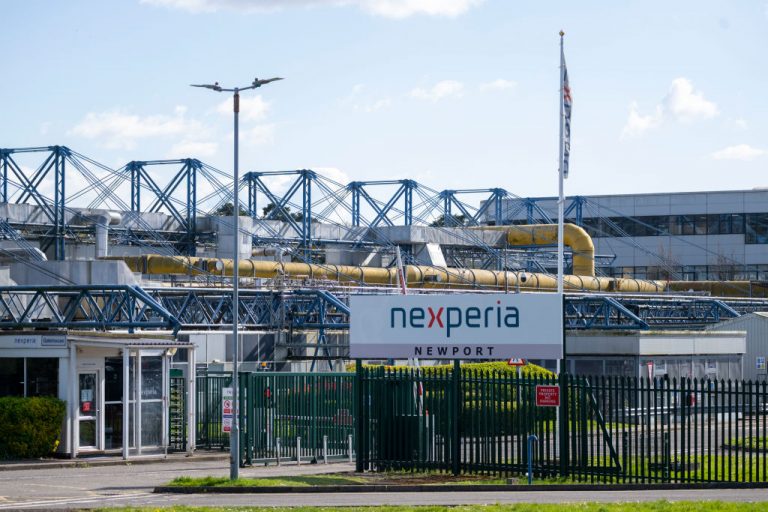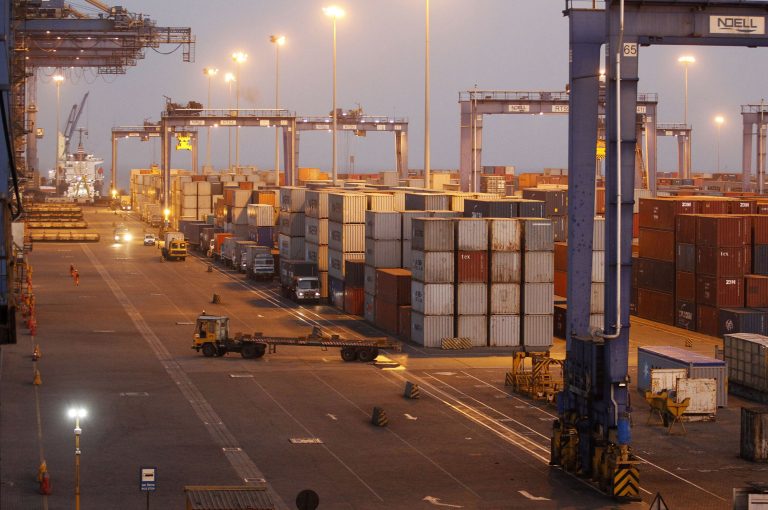The government of the United Kingdom declined to exercise newly-appointed national security powers to intervene in a case involving a hostile takeover of the country’s largest semiconductor manufacturer by a Chinese Communist Party-owned company.
On April 1, Politico Europe announced the UK had “quietly approved” the 63 million pound purchase of Newport Wafer Fab (NWF) by Nexperia, a Netherlands-based company that is simply a wholly-owned subsidiary of Shanghai-based Wingtech.
Politico stated, based on information from “two government officials,” that after a six month inquiry, National Security Advisor Stephen Lovegrove “concluded there were not enough security concerns to block” the transaction.
A long story
In 2017, Neptune 6 purchased a subsidiary of Germany’s Infineon called IR Newport Ltd. for an undisclosed amount, rebranding the company to Newport Wafer Fab, the name the company held in 2003 before a previous acquisition.
A press release announcing the acquisition stated that HSBC and the Welsh Government were “credited with ‘facilitating the transaction.’”
RELATED READING
- China’s Military Supercomputer Maker Sugon Freed In Biden’s Revision to China Blacklist
- Communist China Using Water to Create Chaos at Home and Abroad
- Bitcoin in the Jaws of Communist China
Success
You are now signed up for our newsletter
Success
Check your email to complete sign up
As the company quietly conducted its operations, in June of 2019, NWF announced it had “completed a multi-million pound refinancing deal,” which “involved a restructure of existing Welsh Government loans and a new asset finance facility from HSBC UK,” according to South Wales Argus.
A December 2019 advertorial published by Insider Media painted a picture that all was well within NWF as the company sought to increase production from 8,000 to 11,000 wafers per week.
In the piece, Director of External Affairs and Quality Sam Evans, nonchalantly revealed the true value of the firm, “If you were to build Newport Wafer Fab today from scratch, it would be in the region of a billion pounds.”
NWF primarily remained off the radar until January of 2021 where reporting by The Telegraph characterized the 2017 acquisition as a “management buyout” that “rescued” the firm from Infineon’s plan to close operations.
In the article, NWF Chairman and Neptune 6 head Drew Nelson called on the government for further investment, stating, “There’s a ready made series of projects in the UK, which just need investment” as Nelson expressed the wish to commence a 50 million pound expansion.
“The Government hasn’t really grasped the importance of investment in sovereign capabilities in its own semiconductor industry,” he stated.
The article also revealed that a year-and-a-half later, NWF was still seeking venture capital stimulus to increase its production from 8,000 wafers a week, aiming for a new target of 14,000.
The company’s desires were rooted in light of demand that Nelson described as having “absolutely skyrocketed” amid the global chip shortage and push for electric vehicles.
A cry for help
Only a few months later by May of 2021, UK media started to report that NFW had suddenly written to UK Business Secretary Kwasi Kwarteng sounding the alarm after Nexperia managed to occupy two seats on the company’s Board of Directors amid a “contract dispute.”
A Nexperia spokesperson told The Verdict, “Nexperia is the second-largest shareholder in Newport Wafer Fab since 2019 and has contractual rights to appoint [the majority of the] board members in defined circumstances.”
The spokesperson also dismissed NWF’s call for help as merely a “rumor.”
Kwarteng’s office told the outlet, “The UK government does not consider it appropriate to intervene at the current time.”
By July, the true nature of the situation was revealed to the public in an article by The Telegraph that stated the Welsh government originally loaned NWF 13 million pounds during its 2017 acquisition, which was repaid in full with interest.
The government was paraphrased as stating that while “it had considered investing again,” a spokesperson was directly quoted as stating in no uncertain terms:
“However, an agreement between the then majority shareholders of NWF and the then minority shareholder, Nexperia, gave legal rights to Nexperia which made it impractical for new investors, including the Welsh Government, to put further investment into the business.”
In additional coverage, The Telegraph elucidated that NWF “has been forced into the sale after being unable to fulfill production obligations, allowing Nexperia to take command of the plant.”
A Reuters article not only revealed that NWF would be dumped to Nexperia for a 63 million pound pittance, but that the firm was in long-standing trouble as revenues had fallen dramatically from 49 million pounds in 2019 to only 30 million pounds in 2020.
An article on the takeover by CNBC revealed that NWF was also saddled with significant debt, owing HSBC 20 million pounds, in addition to an additional 18 million pounds outstanding to the Welsh government, which would be repaid by Nexperia during the takeover.
CNBC also stated that in the deal, Chairman Nelson, the firm’s top shareholder, was anticipated to collect 15 million pounds in the turnover.
Prime Minister Boris Johnson overruled Kwarteng, directing Lovegrove’s office to conduct a review under newly-created national security laws first drafted in November of 2020.
Red hues
CNBC’s report also showed that the Nexperia takeover was cause for concern because the firm was 100 percent acquired by Shanghai-based Wingtech in 2019.
The Times states that Wingtech is also a supplier for Huawei, the CCP-backed telecom giant at the center of a hotly-disputed international 5G rollout.
Wingtech earned further notoriety, CNBC stated in a second article, because the company “is heavily backed by the Chinese Communist Party.”
RELATED READING
- 17 Struggling UK Independent Schools Bought by Communist China: Report
- Beijing Bought More Than £135 Billion of British Energy, Education, Tech: Report
- British Scientists Found to be in Cohesion with Chinese Research Institutions That Help Develop Weapons
Based on analysis from analytics firm Datenna, the outlet revealed that 30 percent of Wingtech’s shares traced back to CCP-controlled, Chinese government entities.
At the time, Datenna shared their data exclusively with CNBC. However, the findings, which are now publicly available on the firm’s website, also revealed that, “At the time of the acquisition, it was stated that the management team of Nexperia would remain unchanged.”
“However, only half a year later CEO Frans Scheper was replaced by Zhang Xuezheng and sent on early retirement. Zhang Xuezheng is also CEO and Chairman of the board of Wingtech Technology.”
In an additional August of 2021 article, CNBC reported that immediately after Nexperia exercised the hostile takeover of NWF, Mark Granahan, CEO of Pennsylvania-based Ideal Semiconductor, which sourced the production of its wafers from the Welsh firm, said supply had “come to a screeching halt.”
Speak no evil
In Politico’s coverage of Lovegrove’s decision to green light the sale, the outlet downplayed the significance of Nexperia’s takeover.
The outlet quoted a “former security official who did not want to be named because of the sensitivity of the decision” as stating, “What Newport Wafer Fab do at the moment is not that exceptional — you can argue that it’s not strategically important, and that’s a plausible case.”
Using comments from an additional, albeit anonymous, “serving government official,” the outlet added the additional layer of rhetoric: “Lovegrove reached the same conclusion as the deputy national security adviser who initially looked at the takeover.”
“The official said Newport Wafer Fab uses 20-year-old technology which the Chinese already have.”
The narrative is consistent with similarly framed messaging spanning all the way back to July of 2021, where outlets such as The Conversation claimed that NWF was “not in the same league,” as say, industry leader Taiwan Semiconductor Manufacturing Corporation (TSMC), who produces regular chips with as small as 3 nanometer circuitry, compared to NWF’s 180 nanometer compound products.
Not-so-microscopic discrepancies
Despite Newport Wafer Fab’s alleged incompetency and low value, The Guardian reported in August of 2021 that a consortium of nine domestic firms had stepped forward, announcing their intention to purchase NWF should the Johnson Administratione exercise its national security powers to quash Wingtech’s takeover.
The group stated it was ready to inject 300 million pounds into the company, expanding its operations.
According to the article, three of the firms involved were former NWF clients who wished to maintain their supply chain, and three were financial institutions.
The consortium was also open to providing Nexperia with a minority interest in the company as compensation.
An April 1 article by the China Research Group (CRG) fully elucidated the nature of the Welsh fabricator’s importance both to the UK and the CCP.
In explaining the difference between the compound semiconductors NWF produces and normal semiconductors, such as those made by TSMC, the CRG eviscerated the notion espoused by establishment media that NWF is an inconsequential firm producing outdated technology:
“Compound semiconductors (also known as third-generation chips) differ from standard silicon chips by combining two or more elements from the periodic table to form a compound, such as gallium nitride or silicon carbide.”
“Innovation in silicon chips is about chasing Moore’s law by trying to shrink the nanotechnology to make more advanced semiconductor chips,” CRG states.
“But in compound semiconductors, the nanometre size of the wafer is not a relevant measure: the crucial aspect is the development of advanced compound semiconductor materials.
It adds that compound chips “are used where silicon can not operate, such as high power and very high frequency radio equipment” utilized in critical technocracy applications such as facial recognition sensors and also in electric vehicles.
The CRG also noted that both the Shanghai and national branches of the CCP specifically identify gallium nitride and silicon carbide compound semiconductors and integrated circuits as primary focuses in their 2021-2025 five-year plans.
A domestic keystone
Additionally, the article explained that Newport Wafer Fab served as both the anchor company and chip foundry for the entire CSConnected cluster, a joint Welsh-UK Government initiative designed to bolster the country’s compound semiconductor sector.
When Neptune 6 purchased NWF in 2017, the press release quoted legal director Steve Berry as stating the fabricator was “extremely well placed to contribute to the rapidly emerging International Compound Semiconductor Cluster of South Wales.”
While the cluster generates close to 600 million pounds in revenue annually, NWF was the sole recipient of at least 43 million pounds in additional funding from UK Innovation and Research, according to CRG.
The firm also entered into a 5.4 million pound agreement with UK Innovate “to develop RF MMIC high-frequency gallium nitride designs for defence 5G radar systems” for military applications.
April 5 reporting by the BBC said that, facing public pressure, the Johnson administration had since formally contradicted Politico’s reporting by stating “no decisions have been made” on the acquisition.
The article muddied the waters further when it quoted MP Tom Tugenhadt, Chairman of the Foreign Affairs Committed, who claimed “so few details have been provided to the committee, that we are left with the unfortunate conclusion that no review has taken place.”







